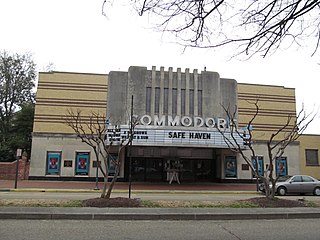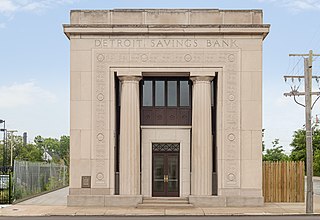
The Fox Theatre is a performing arts center located at 2211 Woodward Avenue in Downtown Detroit, Michigan, near the Grand Circus Park Historic District. Opened in 1928 as a flagship movie palace in the Fox Theatres chain, it was at over 5,000 seats the largest theater in the city. Designed by theater architect C. Howard Crane, it was listed on the National Register of Historic Places in 1985.

The Gem Theatre is a performing arts theater located in Detroit, Michigan. Built in 1927 in the Spanish Revival style, it houses a two level theater with traditional row and aisle seating along with stage-level seating at cabaret tables. The Gem Theatre was listed on the National Register of Historic Places in 1985. It shares a lobby with the cabaret-style Century Theatre, built in 1903.

Peery's Egyptian Theater is a movie palace located in Ogden, Utah, United States. It was added to the National Register of Historic Places in 1978.

The Fillmore Detroit is a multi-use entertainment venue operated by Live Nation. Built in 1925, the Fillmore Detroit was known for most of its history as the State Theatre. It is located near the larger Fox Theatre in the Detroit Theatre District along Woodward Avenue across from Comerica Park and Grand Circus Park. The Fillmore Detroit features a theatre with a Grand Lobby and three levels of seating, as well as the State Bar & Grill which has a separate entrance and is open when the theatre is not hosting events. The Detroit Music Awards are held annually at The Fillmore Detroit in April. The building was listed on the National Register of Historic Places in 1982.

TheWar Memorial, also known as the Russell A. Alger Jr. House and as the Moorings was dedicated to the memory of veterans and soldiers of World War II. It is located at 32 Lake Shore Drive in Grosse Pointe Farms, Michigan.

The Wayne State University historic district consists of three buildings on 4735-4841 Cass Avenue in Midtown Detroit, Michigan: the Mackenzie House, Hilberry Theatre, and Old Main, all on the campus of Wayne State University. The buildings were designated a Michigan State Historic Site in 1957 and listed on the National Register of Historic Places in 1978.

The Broadway Theater District in the Historic Core of Downtown Los Angeles is the first and largest historic theater district listed on the National Register of Historic Places (NRHP). With twelve movie palaces located along a six-block stretch of Broadway, it is the only large concentration of movie palaces left in the United States. The same six-block stretch of Broadway, and an adjacent section of Seventh Street, was also the city's retail hub for the first half of the twentieth century, lined with large and small department stores and specialty stores.

The Jefferson Intermediate School is a school building located at 938 Selden Street in Detroit, Michigan. It is also known as Jefferson Junior High School or Jefferson School. The school was listed on the National Register of Historic Places in 1997.

The Cass Park Historic District is a historic district in Midtown Detroit, Michigan, consisting of 25 buildings along the streets of Temple, Ledyard, and 2nd, surrounding Cass Park. It was listed on the National Register of Historic Places in 2005 and designated a city of Detroit historic district in 2016.

The Monroe Avenue Commercial Buildings, also known as the Monroe Block, is a historic district located along a block-and-a-half stretch at 16-118 Monroe Avenue in Detroit, Michigan, just off Woodward Avenue at the northern end of Campus Martius. The district was designated a Michigan State Historic Site in 1974 and listed on the National Register of Historic Places in 1975. The thirteen original buildings were built between 1852 and 1911 and ranged from two to five stories in height. The National Theatre, built in 1911, was the oldest surviving theatre in Detroit, a part of the city's original theatre district of the late 19th century, and the sole surviving structure from the original Monroe Avenue Commercial Buildings historic period.

The Ulster Performing Arts Center (UPAC), originally the Broadway Theater and Community Theatre, is located on Broadway in Kingston, New York, United States. A Classical Revival building built in 1926, it is the only unaltered pre-World War II theater left in the city, and one of only three from that era in the Hudson Valley. It is also the largest proscenium theater between Manhattan and Albany.

The Orpheum Theatre is a historic theater in downtown Wichita, Kansas, United States. It was designed by renowned theatre architect John Eberson with funding from a group of local investors and opened on September 4, 1922.

MorningSide is a neighborhood on the east side of Detroit, Michigan. The area is bounded by Harper Avenue and Interstate 94 on the north, Mack Avenue to the south, East Outer Drive and Whittier on the east and Alter Road and East Outer Drive to the west. The local association that shares the name MorningSide with the community is a collaboration of residents working together to take care of this area. Michigan Public has made Morningside the subject of in depth coverage.

Queens Theatre, formerly Queens Theatre in the Park and before that Queens Playhouse, is an American professional theatre at Flushing Meadows–Corona Park in Queens, New York City, U.S. Artistic and Executive Directors have included Joseph S. Kutrzeba, founder and producer; Robert Moss, Sue Lawless, Jeffrey Rosenstock and Ray Cullom, formerly Managing Director of Long Wharf Theatre in New Haven, Connecticut, and currently, Taryn Sacramone, former Executive Director of Astoria Performing Arts Center.

The Hollywood Theater is a historic theater building in Minneapolis which is listed on the U.S. National Register of Historic Places. It is located in the Audubon Park neighborhood of Minneapolis.

Commodore Theatre is an historic movie theater located at Portsmouth, Virginia. It was built in 1945 in the Streamline Art Deco style, and originally sat 1,000 people. The theater closed in 1975 and sat empty until a change in ownership and extensive renovation beginning in 1987. It reopened two years later, and as of 2023 was in operation displaying first-run films accompanied by a full kitchen.

The Terrace Theatre was located at 3508 France Avenue North in Robbinsdale, Minnesota. Upon its opening on May 23, 1951, the Terrace received critical acclaim for its “bold architectural lines [and] extensive patron services.” The 1,299-seat theater, designed in the mid-century modern style by the Minneapolis architectural firm of Liebenberg & Kaplan (L&K) for movie exhibitors Sidney and William Volk, was a popular Twin Cities destination for nearly fifty years. It changed hands in 1980 and again in 1987, when it was remodeled from a single-screen auditorium into three screens by dividing the balcony. The last movie was screened in 1999 and the theater remained boarded up for seventeen years before it was demolished in the fall of 2016 to be replaced by a Hy-Vee grocery store.

The New Center Commercial Historic District is a commercial historic district located on Woodward Avenue between Baltimore Street and Grand Boulevard in Detroit, Michigan. It was listed on the National Register of Historic Places in 2016.

The Detroit Savings Bank Southwest Branch is a former branch bank building located at 5705 West Fort Street in Detroit, Michigan. The building is significant as one of the works of Wirt C. Rowland, then working at the firm established by Albert Kahn. It was listed on the National Register of Historic Places in 2021.

The Ambassador Theater is a historic Streamline Moderne movie theater on Liberty Heights Avenue in the Howard Park section of Baltimore, Maryland. It is listed on the National Register of Historic Places and is a designated Baltimore City Landmark.

























